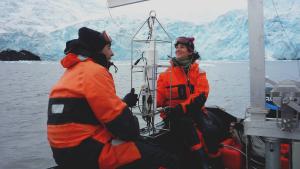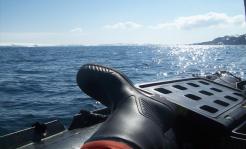Marta: sus estaciones oceanográficas acompañada por ballenas - Marta: oceanografic stations with company
Ola! Yo soy Marta Sierra y formo parte del grupo de Oceanografía del Instituto Antártico Argentino. [blog in Spanish and English]
Nuestro trabajo se inicio el verano pasado realizando una batimetría detallada de la caleta Potter. Actualmente estamos completando algunos gaps de la batimetria.
 Saliendo: Oscár manejando bote y yo gozando el clima - leaving base: Oscár driving the boat and I am craving the sunshine |
Por otra parte realizamos una grilla de estaciones oceanográficas con CTD (Seabird 19+), para estudiar la influencia en las características de las masas de agua de la caleta según el ciclo de marea (sicigia/cuadratura). Este año intentamos realizar estaciones tipo yo-yo durante los días de mayor y menor amplitud de la marea. Yo yo quiere decir, estaciones fijas en un lugar cada 2 horas de acuerdo al regimen de la marea. Lo hacemos … siempre que el clima lo permita.
 Preparando el CTD con Maxi - getting the CTD ready with Max |
 Working on the boat with Pablo and Maxi |
También el estado del tiempo (especialmente del viento) influye en la distribución de las masas de agua y en la circulación de la caleta. Por eso hemos instalado una estación meteorológica en Punta Elefante.
Esta es la segunda vez que vengo a Jubany, y debo decir que no podría ser mejor, trabajar en un lugar tan hermoso es una experiencia única!
Hi! I am Marta Sierra and part of the physical oceanography team of Instituto Antártico Argentino (Buenos Aires). Our work began last summer by making a detailed bathymetric map of Potter Cove. Currently we are still filling some gaps in the bathymetric map of the Cove.
 A humpback whale was curiously circling our boot - Una ballena nos acompaño mientras muestreando |
On the other hand we make a grid of oceanographic CTD stations using a Seabird 19+, to study spring/neap tide influence on the characteristics of the water masses. This year we will try to make some yo-yo stations during the days of higher and lower tidal amplitude... every time the weather permits. “Yo-yo” means that we are recording the vertical profile of temperature and salinity distribution in the same spot every 2 h, relating it to the rhythm of the tides.
Further, because weather conditions (especially the wind) affect water mass distribution and water circulation, we have a meteorological station installed in Punta Elefante (Elefant Point), a location close to the station.
This is my second time on Jubany, and I have to say that it couldn`t be better, working in such a beautiful place is a unique experience!
 From time to time life can be so good in Antarctica - de vez en cuando la vida en Antártida te hace un regalito! |
 Returning home after 4 hs of sampling - volviendo a Jubany despues de 4 hs en bote and just passing Punta elefante (to the right) |

